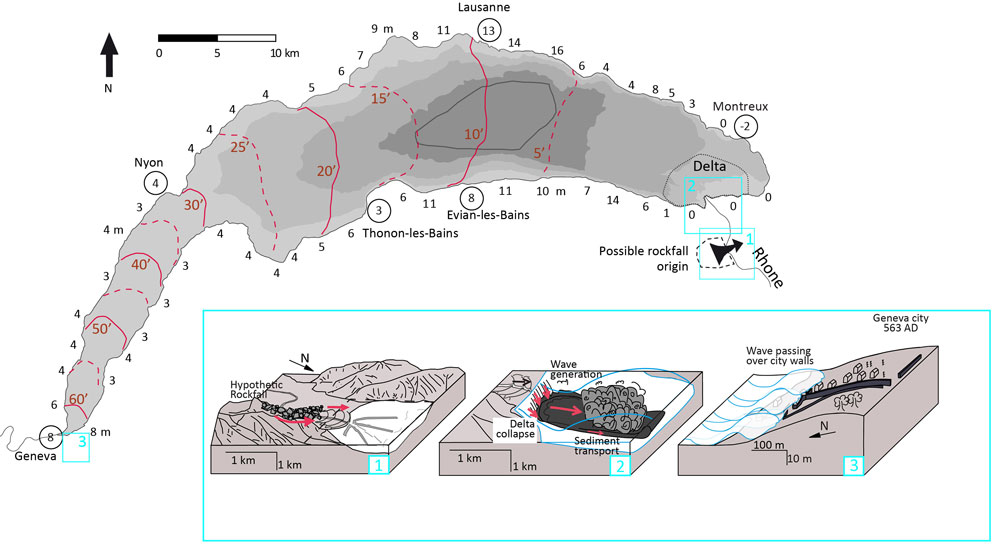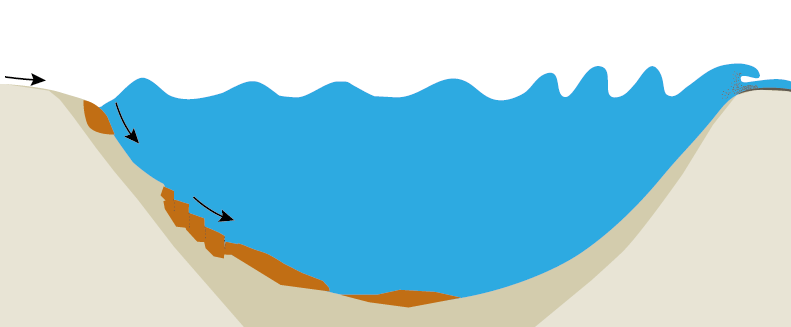Lake Tsunamis
Tsunamis do not only occur in the sea. In rare instances large seismic waves also occur in (Swiss) lakes.
Causes
Tsunamis at sea occur when an earthquake abruptly raises or lowers the ocean floor (if the sea floor only shifts horizontally, this has little impact on the mass of water above it) and / or when a submarine landslide takes place.
The height and speed of tsunami waves depend on the parameters that triggered the quake and on the depth of the water. As a rule, waves propagated in deep water do not pose a danger and are recorded only by measurement buoys (if noticed at all). But as soon as they reach shallower waters, the mass of water towers high and can flood entire stretches of coastline, depending on the vertical displacement of the ground.
Since tsunami waves move more slowly than the P waves of an earthquake (see frequently asked question: "What are P, S, Love and Rayleigh waves?"), endangered areas can be given several minutes' or even several hours' warning of an impending tsunami.
Lake tsunamis are usually caused by rock avalanches or sliding sediment, either above or below water, which are in turn often, though not always, triggered by earthquakes. The height of a tsunami wave caused by a submarine landslide depends mainly on the volume of sediment displaced and the speed of the landslide.
Flash floods in Switzerland
Evidence of rock avalanches and landslides that triggered flash floods in Switzerland's history and prehistory has been found in many Swiss lakes, taking the form of chaotically mixed deposits that differ markedly from normal sediments. Since their age can be ascertained, they can be retrospectively attributed to a seismic event. The height of the flash flood wave can be calculated by numerical models and then compared with historical reports.
The following flash floods in Swiss lakes have been historically documented:
- In 563 A.D., a rock avalanche in the Rhone Valley triggered a submarine landslide in the river's delta. This slide in turn generated a wave up to 13 m high, which swept over the bank of Lake Geneva, flooding the old city of Geneva (Kremer et al., 2012).
- In 1584, an earthquake near Aigle destroyed villages and caused rockslides. A tsunami in Lake Geneva was observed (Fritsche et al., 2012).
- On 18 September 1601, an earthquake with a magnitude of 5.9 caused submarine landslides in Lake Lucerne, triggering a 4-m-high tsunami wave that engulfed the city of Lucerne (Schnellmann et al., 2002; Siegenthaler et al., 1987).
- On 23 September 1687, parts of the Muota delta slid into Lake Lucerne, triggering a wave 5 m high (Hilbe and Anselmetti, 2014).
- On 2 September 1806, the village of Goldau was destroyed by a rock avalanche that caused a 10-m-high tsunami wave in Lake Lauerz (Bussmann and Anselmetti, 2010).
- In 1996, the remains of a human body between 190 and 290 years old were found in Lake Brienz, freed from the mud by a smallish landslide in the Aare delta that triggered a wave 1 m high. This unusual movement of water was observed by employees of the company Aarekies (Girardclos et al., 2007).
These historical examples show how different the causes of lake tsunamis can be and suggest that the possibility of future flash floods in Swiss lakes cannot be ruled out. However, there is no way of predicting where or when these phenomena may occur or what form they might take.

